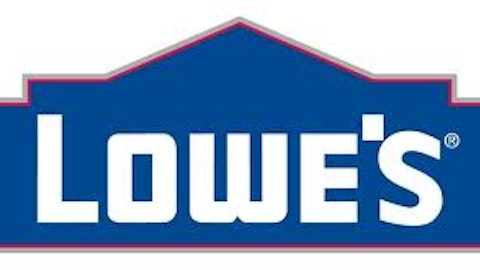Lowe’s net profits in 2006 were $3.1 billion. 2015 profits are expected to be $3.1 billion as well. Lowe’s has not managed to grow the profitability of its underlying business. The company has rewarded shareholders with share repurchases, however.
From 2006 through 2015, Lowe’s has reduced its share count by over 6% a year. Lowe’s has returned nearly all of its earnings to shareholders through share repurchases alone since 2006. The company’s debt levels have increased (but are still reasonable) as management has used debt to fund dividends and growth while paying out earnings as share repurchases.
Going forward, I expect Lowe’s to deliver shareholders total returns of 7.5% to 10.5% from the following sources:
– Share repurchases of 4% to 6% a year
– Organic growth of 2% to 3% a year
– Dividends of 1.5% a year
Recession Performance
As mentioned earlier in this article, recessions affect Lowe’s. The Great Recession caused Lowe’s margins to compress.
Lowe’s had earnings-per-share of $1.99 in 2006. The company did not hit new earnings-per-share highs until 2013, 7 years later. Holding on to a stock for 7 years is a long time to wait for a recovery.
Lowe’s did remain profitable through the Great Recession, but earnings-per-share fell sharply.
The company’s earnings-per-share from 2006 through 2013 are shown below to give an idea of how recessions impact Lowe’s:
– 2006 earnings-per-share of $1.99 (high at the time)
– 2007 earnings-per-share of $1.86 (start of recession)
– 2008 earnings-per-share of $1.49
– 2009 earnings-per-share of $1.21 (recession low)
– 2010 earnings-per-share of $1.44 (start of recovery)
– 2011 earnings-per-share of $1.69
– 2012 earnings-per-share of $1.76
– 2013 earnings-per-share of $2.16 (new high at the time)
Lowe’s Stock Price Valuation
Lowe’s is currently trading at a price-to-earnings ratio of about 23 times expected 2015 earnings.
The company has historically traded at a premium to the S&P 500’s price-to-earnings ratio of about 1.1x – when the United States housing market is strong.
The S&P 500 is currently trading for a price-to-earnings ratio of 21.8. This implies a fair price-to-earnings ratio of around 24.0 for Lowe’s in today’s overpriced (relative to historical averages) market.
When the United States housing market is weak Lowe’s trades at a discount of about 0.8x to the S&P 500’s price-to-earnings ratio.
It is best to purchase shares of Lowe’s during weak housing markets, and sell the stock when its price-to-earnings multiple expands and housing markets are strong. Now is not the time to start a position in Lowe’s.
Final Thoughts On Investing In Lowe’s
Lowe’s Companies, Inc. (NYSE:LOW) does not rank particularly well using The 8 Rules of Dividend Investing. The company has a below-average 1.5% dividend yield and an above average stock price standard deviation of 31%.
On the bright side, the company does offer investors decent total return potential thanks to its large share repurchases and shareholder friendly management. Additionally, Lowe’s has a conservative payout ratio which makes continued dividend growth very likely.
In the final analysis, investors looking for exposure to the North American home improvement market should consider Lowe’s when the housing market is struggling and the company’s shares can be picked up at a discount, not during bull markets.
Disclosure: None





